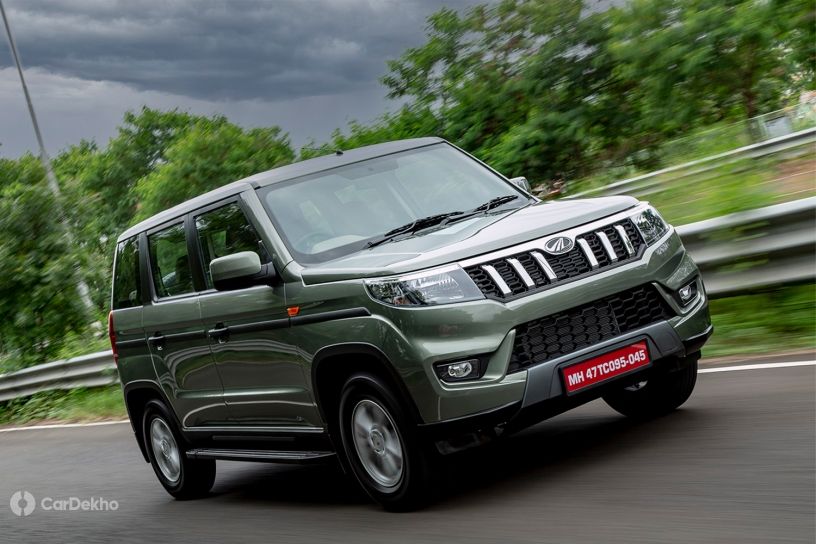Mahindra Bolero Neo Detailed In 11 Pictures
Published On Jul 17, 2021 10:17 AM By Sonny
- Write a comment
Take a closer look at Mahindra’s rugged sub-4m SUV that’s a lot comfier than the regular Bolero

The Mahindra TUV300 preceded the XUV300 as the brand’s competitor in the sub-4m SUV space. Its second facelifted avatar with a BS6-compliant engine has now been introduced under a new identity and it is called the Bolero Neo. We’ve already compared it against the standard Bolero, but now we’re taking a closer look at the Bolero Neo itself in the gallery below:
Front

The Bolero Neo’s front fascia looks more premium than that of both the discontinued TUV300 and the current Bolero. Its grille looks sleek and is only a little taller than the headlamps, and the aperture for the air dam takes up most of the lower bumper.

The LED daytime running lights are positioned just below the bonnet line and are connected by the top strip of the chrome grille. Even though the headlamps are still halogen units, they don’t look dated like the ones on the model it replaces.
Various curves of the front bumper, like the styling for the front fog lamp housing, give the Bolero Neo some premium appeal. The front skid plate is integrated into the bottom part of the bumper and houses the number plate as well.
Side

While the Bolero Neo is still a tall offering, the increased rake of the front end makes it look less boxy and more dynamic. The short overhangs with the 15-inch wheels still look somewhat disproportionate from the overall stance of the vehicle.
The blacked out B and C pillars also add to the relatively premium appeal of the Mahindra Bolero Neo.
Its tall stance and high ground clearance will also appeal to those who enjoy a higher seating position and the ability to deal with all manner of potholes and badly designed speed humps.
Rear

This is what differentiates the Bolero Neo from most of its segment rivals, that urban appeal. It still has a vertically-hinged tailgate with a spare tyre mounted to it that has a body-coloured X-bracket (silver coloured for the top variants) with Bolero branding for some style points.
The rear is also the flattest side of the Bolero Neo, almost like a vertical cut off from the rest of the car. This could be seen as an advantage when parking in very tight areas but the aesthetics don’t hold up against the competition. The vertical tail lamps look as dated as the rest of the rear-end design of the Bolero Neo and have not been changed since the TUV300 debuted in 2015.
Wheels

As mentioned earlier, the Bolero Neo is only available with 15-inch wheels but the top variant does get the sporty looking alloys seen here.
Interior

The cabin of the Bolero Neo has almost nothing in common with the rugged SUV it borrows its name from. However, it does look nearly identical to the cabin of the TUV300 that it is actually based on. It features beige upholstery, contrasted only by the dual-tone dashboard with the entire console section in black.

The Bolero Neo’s top variant is fitted with a 7-inch touchscreen infotainment system, positioned below the central AC vents. Sadly, it does not offer Android Auto and Apple CarPlay connectivity. This central display is flanked by various controls for the infotainment system and the whole unit has a gloss-black finish. The three dials for the manual climate control are located below the infotainment system.

The central console has a 12V power outlet, a USB port and an AUX port with a small storage stray on the left of the gear selector. Controls for the electric windows are located further back on the central console tunnel.

The steering wheel design looks dated but does feature controls for the infotainment system and for cruise control as well.

In the back, it has two headrests and three-point seatbelts for the corner seats but not for the middle seat. If the middle space is empty, the other rear passengers can use the fold out armrest too.

Behind the back seat of the Bolero Neo, in the ‘boot’ area, you’ll find two jump seats which technically make this a seven-seater much like the regular Bolero. The bases of these seats can be folded up like a cinema seat and held in place by a strap, to make use of the 348 litres of storage space. While these two extra seats are not ideal for anything more than a short trip, they’ll be helpful in a pinch instead of having to seat two kids in the laps of the three adults sitting on the rear bench.
Also read: Three-row Mahindra Bolero Neo Plus Expected To Launch Soon
Final Thoughts
The Bolero Neo looks a lot better than the TUV300 that came before it and notably more premium than the standard Bolero. It presents a rugged alternative to the city-centric sub-4m SUVs in a similar price range. This Mahindra offering is also a good step-up for Mahindra’s target audience that wants something as rugged as the Bolero but with a more comfortable cabin.
The Bolero Neo is only available with a 1.5-litre diesel engine mated to a 5-speed manual 100PS and 260Nm, which is slightly more performance than offered with the regular Bolero. Since it’s a body-on-frame SUV with rear-wheel drive, it also offers a different dynamic experience from most sub-4m SUVs in the market. The top spec N10(O) variant will also feature a mechanical locking rear differential.
Mahindra has launched the Bolero Neo with prices ranging from Rs 8.48 lakh to Rs 10 lakh, with the top-spec N10(O) variant’s prices to be announced soon.
Read More on : Mahindra Bolero Neo diesel
1 out of 1 found this helpful















